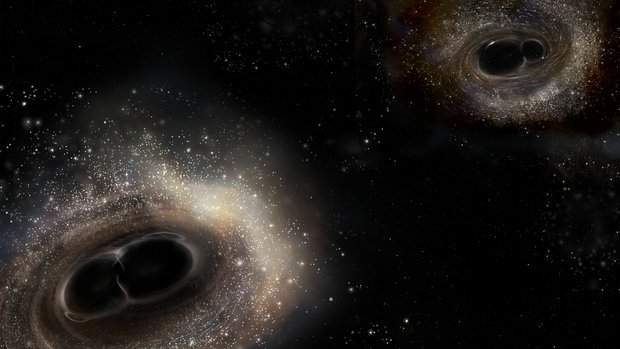
From CBC
A third gravitational wave has been detected by the Laser Interferometer Gravitational-wave Observatory (LIGO) after the merging of two black holes galaxy three billion light-years away, scientists say.Read more: http://www.cbc.ca/news/technology/third-gravitational-wave-ligo-1.4140054The colossal merger was detected on Jan. 4, just over a month into LIGO's observing run.
The first detection of such an event was headline news in September 2015. Worldwide, scientists were thrilled to discover an event theorized by Albert Einstein 100 years ago in his general theory of relativity. A second one was detected in June 2016.
Gravitational waves detected for 1st time
Gravitational waves reveal new type of black hole
Black holes are some of the most massive objects in our known universe, which pull in anything that gets too close, including light. When two merge, they produce an incredibly subtle signature — the gravitational wave — which warps space-time.These ripples in space-time can only be detected by powerful instruments. LIGO, operated by Caltech and MIT with hundreds of people working around the world, includes two detectors — one in Hanford, Wash., and the other in Livingston, La. — that are capable of measuring a ripple by as little as 1/1,000th of a proton.
In terms of mass, this newly created black hole sits right between the first two detected, at 49 times that of our sun. The first one was 62 solar masses, the second 21. This is also the furthest gravitational wave detected, with the others roughly 1.4 billion light years away.
"So far all the binary black holes observed all have different masses," said Harald Pfeiffer, a scientist at the Canadian Institute for Theoretical Astrophysics at the University of Toronto who is part of the LIGO team.
"This indicates that there's quite a variety in the type of black holes that emit gravitational waves that are colliding with each other."
Spin and tilt
The new data also helps astronomers determine how binary black holes are created. As a pair of black holes spiral around one another, they also rotate, in the same manner planets or moons do. Sometimes they spin in the same direction in which they are moving, other times in the opposite direction. They can also be tilted.
While the detection doesn't tell scientists if these doomed black holes were tilted or not, it does suggest that one of them may have been spinning in the same direction.
'We're learning where we're coming from. And that's the big excitement.'
- Laura Cadonati, LIGO Scientific Collaboration
Astronomers are particularly interested in determining how binary black holes are created. One theory suggests that they are formed separately and then come together, which could have spins in any direction.Another is that they form from already paired stars that collapse into black holes. If they are formed in this manner, it's believed that the spins would be in the same direction. Because only one has been found that may have been spinning in a different direction suggests that the pair were formed separately.
Follow @contentjunkie to stay up to date on more great posts like this one.

That is indeed a great news. If I am allowed to self-advertise myself, I tried to explain how the detection actually went here.
Downvoting a post can decrease pending rewards and make it less visible. Common reasons:
Submit
LOLOL Bullshit.
Downvoting a post can decrease pending rewards and make it less visible. Common reasons:
Submit
Downvoting a post can decrease pending rewards and make it less visible. Common reasons:
Submit
LOL That made my day.
Downvoting a post can decrease pending rewards and make it less visible. Common reasons:
Submit